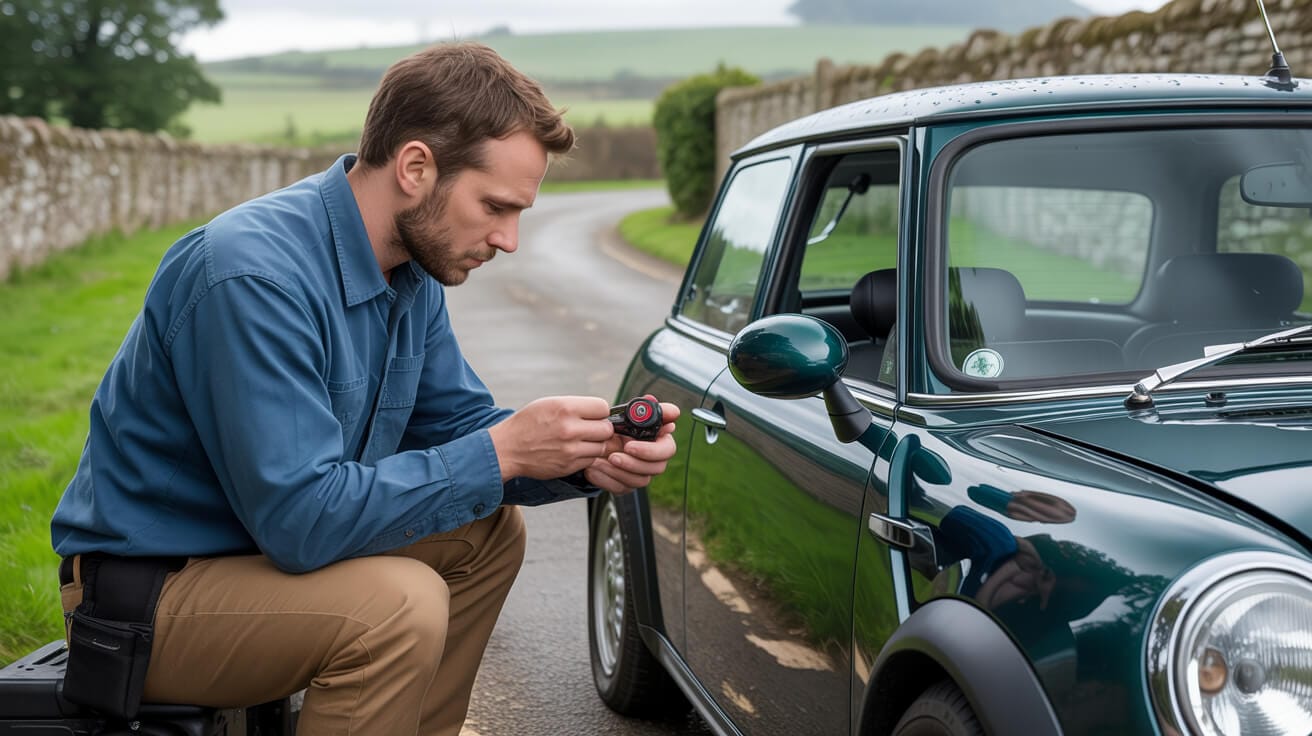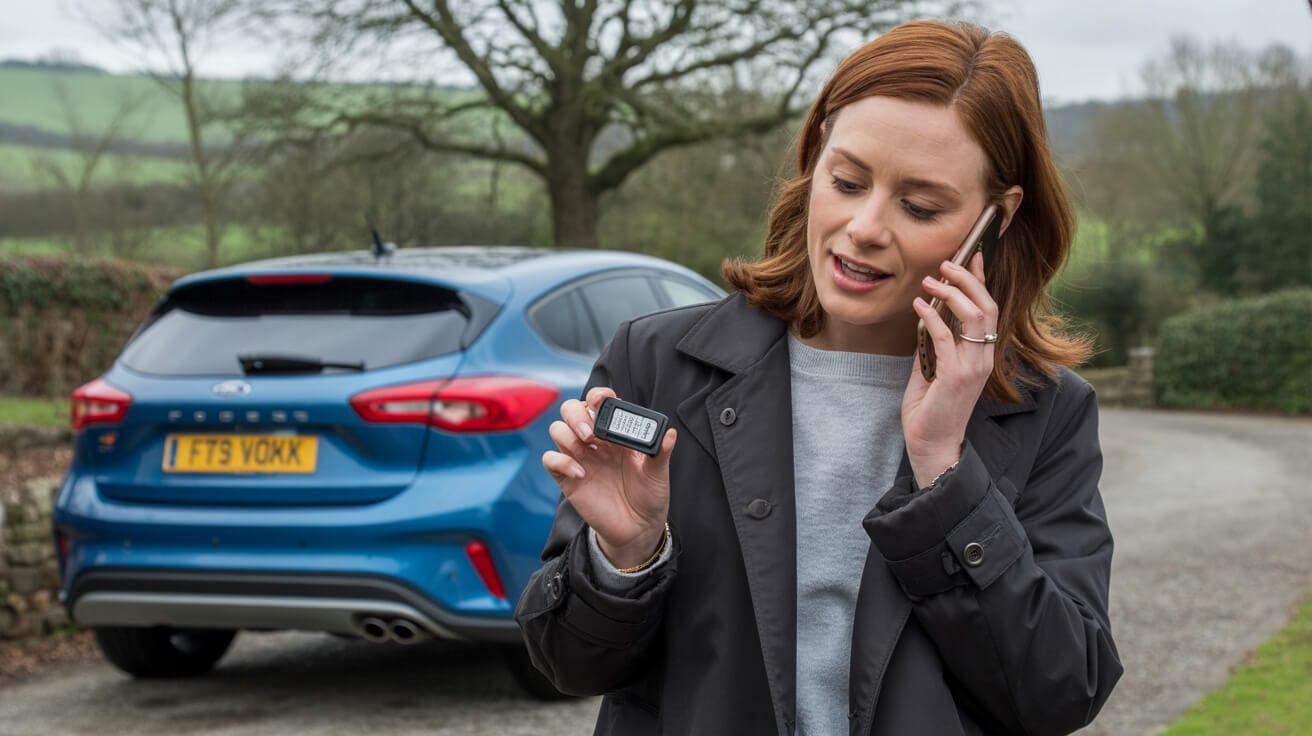What should you do immediately when your key breaks in the lock?
Nothing throws you off faster than a key snapping in your car’s door or ignition, but the smartest move is to pause, take stock, and refuse to cut corners—especially in a crisis. Before you so much as reach for a tool or ring anyone for help, check your own safety. Make sure your environment is secure, particularly if you’re stopped roadside or in a public space, and never let panic dictate your next step. Immediate action doesn’t mean rushing—it means getting the process right from the very start.
The top priority is always proof: confirm you have ownership or full authorisation for the vehicle. UK standards require ID—think driving licence, V5C logbook, or leasing agreement—before a reputable locksmith will even consider extracting the broken key. Skipping this step doesn’t just void potential insurance cover; it leaves you vulnerable if follow-up problems or disputes arise. Every legitimate repair begins with consent and documentation, and that protects you as much as any fix.
When you act with control and ensure paperwork and permissions are handled up front, you stay on the right side of the law—and future warranty or insurance headaches stay off your plate.
The fastest way to slow disaster is to document it: the minute your key snaps, your timeline for a smart recovery begins.
Why professional locksmiths insist on digital logs and proper consent
Breakdowns are messy, but a clear digital record—who, when, which tool, what action—turns your crisis into a traceable, solvable event. Top UK locksmiths refuse to start work until you’ve shown your ID and agreed to job terms, all logged with photos and digital signatures to satisfy GDPR and industry audit standards. The logbook isn’t bureaucracy—it’s your warranty one year from now, your insurance record five years from now, your peace of mind in the moment.
What owner and data protection mean for you
Modern vehicle fixes don’t stop at the lock. Every action, image, and customer detail is handled under strict privacy protocols: encrypted job notes, limited retention, masked serials, and role-based access. You’re entitled to a full privacy commitment from your service provider, so ask for it. When everything’s documented, you avoid disputed bills, false damage claims, and future data headaches. Now, let’s look at why keys break in the first place and how you can stay out of this jam again.
How and why do car keys break—and what can you do to avoid it happening again?

Car keys are tough, but they’re not invincible. The points where metal thins—usually at the tip or just past the bow—double as the most common break sites. Years of twisting, a worn lock, maybe a bit of grit, and stress adds up. But it’s not just old cars or battered keys: today’s advanced keys, with transponders or smart electronic heads, are sometimes even less forgiving if put under the wrong strain.
If your key breaks, snap a quick photo before trying anything else. That image can reveal whether a chunk is still in the lock or if wear played a part. A careful technician uses these clues to stop you from paying twice—once for basic removal, twice for deeper hidden faults. Move fast and you minimise fragment-driven damage; hesitate and you risk rust, jammed internals, or even a write-off on more expensive tech.
Stacking tiny mistakes—tweezers, glue, online “quick tools”—often ends up with costlier repairs and no insurance cover. Smart prevention and fast, fact-based fixes are your best defence.
Your key’s weak point is your chance to cut off trouble before it snowballs. Prevention starts with the first photo, not the first tool.
Where and why does the key break matter?
The biggest headache isn’t just the snap, it’s what gets left behind. Most breaks wedge a jagged end deep inside the lock. If you try “kitchen DIYs,” you risk pushing the fragment further, stripping soft brass, or bending tumblers meant to last years. On keyless or smart keys, accidental short-circuits or pulls can cost hundreds. The location of the fracture guides the right fix—some require a lock dismantle, others need a professional touch on the first visit.
Are quick-fix gadgets or waiting ever worth the risk?
Field audits agree: “as seen on TV” gadgets rarely work and typically escalate costs. Wait too long—overnight, a rainy day, or through a frost—and that fragment can cement, causing everything from stuck doors to blown actuators. Where smart fobs are involved, stray metal can short-circuit or corrupt signal paths, especially in modern systems with immobilisers or rolling codes, leading to new sets of headaches. If you’re moving to a digital key, handling the jammed mechanism first is the best insurance.
How do modern lock systems complicate broken key scenarios?

Modern automotive security turns what should be a simple fix into a systems-level puzzle. Today, keys aren’t just hunks of brass or steel—they’re embedded devices interacting with immobilisers, control modules, and encrypted handshake loops. A snapped fragment doesn’t just block a latch; it can scramble the delicate conversation between your fob, the LF (low-frequency) ring, the electronic gateway, and the car’s brain. It might trigger alarms, set an immobiliser fault, lock you out, or make start/stop buttons unresponsive.
What’s more, in vehicles from 2015 onward, control modules can misread the blocked cylinder as a tampering attempt. Fragments left in place sometimes disrupt signals, triggering a lockout sequence or a cascade of error codes. It’s not rare for false “broken key” symptoms to actually be fatigue in a LIN (local interconnect network) node, a corroded wire harness at the door, or an expired coin cell in a smart fob.
With digital- and hybrid-keyed cars, your entire access system is layered: hardware meets software meets credentials. One overlooked fragment can domino across those layers, inflating your cost and downtime.
The days of just wiggle it out are over—your key is now part of a layered digital security protocol.
Why can a key fragment cause immobiliser or alarm issues?
Embedded chip or transponder systems read metal position and signal in tight sequence. A stuck fragment can block or corrupt the low-frequency (LF) field or create metal-to-metal shorts that confuse the authentication loop. Sometimes, what seems mechanical (stuck, no turn) is really a security channel error—the car thinks it’s under attack and fires off alarms or freezes the start relay.
This is why skilled extraction teams always include a digital check: code reads, status lights, and even basic signal diagnostics to confirm the immobiliser and alarm will reset smoothly after the fix.
Are snap symptoms ever not what they seem?
Many complaints labelled as “broken key” have roots in failed door-module power, LIN-bus wiring fatigue, or software bugs—especially if doors don’t unlock or the start cycle cuts off after the first crank. A proper extraction runs through a hands-on and digital check: pulling DTCs (diagnostic trouble codes), checking LIN/CAN networks for health, and logging reset codes for your records. It’s the difference between a “quick fix” and a guaranteed, insurable recovery.
What makes non-destructive extraction the UK standard—and how do you know it’s happening?

The UK’s gold standard in key extraction is clear-cut: non-destructive first, every time. This standard isn’t hype—it’s tied to insurance rules, OEM warranty agreements, and your own long-term costs. Providers who follow it take extra steps: padded trim, protected paintwork, no forced latch prying, and zero tolerance for crunched connectors or scarred looms. Every movement is photographed, tool-by-tool, with a transparent logbook tracking the entire job.
When providers offer a pre- and post-work demo—doors, alarm, and engine—backed by timestamped records, you see proof that the fix did more than just open a door.
Traceable work is insurable work: if you can sign off, so can your insurer or fleet.
How does the extraction process vary across makes and models?
No two cars quite match. One Ford might use a sidewinder key, another VAG group model could hide a deeper, spring-loaded tumbler or need the whole handle removed for access. Toyota or BMW digital keys often require a “pre-flush” to discharge latent signals and prevent accidental pairing during work. Experienced operators arrive with the right stock—mechanical blanks, transponders, electronic probes—and a playbook for your vehicle, not just generic tricks.
Clever technicians can explain their model-specific path before the first tool is set, protecting your hardware and your warranty.
What are the consequences of fast or forceful extraction?
The shortcut is the slowest route long-term. Rushed, high-torque attempts can trigger airbags, break glass, or set off cascading errors—some invisible for weeks. Sensitive electronics on late-model cars don’t tolerate a ‘smash and grab’ effort, and audit records show failed fast fixes nearly triple follow-up costs. Your repair needs to be invisible, with logs and component checks that pre-empt blame games or failed claims down the road.
Does DIY ever beat professional extraction, or does it just shift the cost and risk?

The notion that DIY is always cheaper is the biggest myth in automotive lockouts. While guides and gadgets make the fix look easy, UK warranty statistics and insurer audits show DIY quadruples the chance of a botched job—damaged cylinders, bent locking tabs, or corrupted smart modules that require total replacements. You lose more than time and money: you may slam the door on future insurance or warranty cover if you can’t provide clean, operator-certified logs.
Professional “first time fix” rates—certified, logged, insured—consistently hit over 90%. DIY rarely makes it past 40% without escalation.
Proof-backed skill doesn’t just solve the problem—it preserves your assets and reputation.
What skills and tools do pro extractors bring that most owners lack?
Trained locksmiths bring surgical tools: professional-grade extractors, calibrated decoders, digital readers for key ID and fob status, and audit-driven service logs. Their van stock isn’t just for show—spares, batteried blanks, and on-hand electronics mean no wait times, wasted attempts, or nearmiss cable tears. Insurance and review platforms back these claims, favouring providers who can show their every step on record—protecting both owners and operators.
How fast do costs and risks stack up in poorly handled fixes?
The costs climb quickly: a push too far or a homebrew solution can break immobilisers, trigger anti-theft lockdowns, or force a BCM (body control module) reset—doubling or tripling your original outlay. Missed audit steps make insurers nervous, while rushed work is the top cause of high-value warranty rejections. The right professional saves money, reduces future claim friction, and gives you documentation stronger than a simple receipt.
How can you truly evaluate and trust a broken key extraction provider?

Not all extraction firms operate at the same level, and trust is earned before your lock is touched. True professionals put their credentials on show: public operator certifications, tool audit logs, and up-to-date client reviews—readily available before booking. In 2023, UK compliance rules mean you’re entitled to see any checklists or booking vetting ahead of a technician sent to your car.
Look for firms that treat transparency as standard, not as an afterthought. Trust grows with every visible proof.
The best provider doesn’t ask you to trust—they make sure you never have to.
What do you gain from verified credentials and audit support?
You’re not just buying a fix; you’re investing in a process. Live certifications, detailed booking records, and automatic after-action reports mean every operator step is visible. When things go right, you drive away without worry; if they don’t, you’ve got the evidence on hand to secure a fix or claim. This data-driven approach is why major fleets and insurers select audit-verified operators by default.
Why should you care about open outcome metrics and supporting data?
Performance is no longer a secret: up-to-date first-time fix rates, warranty rates, and NPS (net promoter scores) are now published by leading firms, meaning you can check exactly how similar jobs turned out. Transparency turns marketing claims into practical, actionable decisions—showing you, before the first call or click, how the real numbers stack up.
Why is the audit trail critical after a broken key extraction—and how can it protect you?

A breakdown handled today could affect your future months or even years down the line—and a clean, full audit path ensures you always come out on top. Every step—from the first phone call to the finished job—should create a clear, signed, and timestamped record. This isn’t paperwork for paperwork’s sake: it’s your insurance passport if a problem crops up, your evidence when contesting a disputed claim, and your warranty backstop should the fix ever fail.
A visible, well-kept record lets you move forward with total peace of mind.
Your audit trail is more than memory—it’s your permanent shield, from incident to outcome.
What new acceptance norms exist for records and evidence?
Insurers, warranty providers, and business fleets are now united on the baseline: if you want a claim paid, you’ll need a full service record, before-and-after photos, and digital time stamps. These are less “nice to have” than “job isn’t finished without them.” Clear, accessible, and owner-downloadable records have become the norm among the best operators.
Are compliance-bonded services now a standard requirement for coverage?
Absolutely—a protocol-bound, audit-proven fix is increasingly the price of entry for insurance and warranty claims. “Grey jobs” done on the hush might seem quicker, but they erode your future claim status and reduce resale value. If in doubt, ask for metrics: response times, warranty rates, operator credentials—these aren’t extras, they’re now default expectations for credible work.
Why trust Autolocks Ltd for broken key extraction, whatever your ownership or credential type?

Fleet managers, digital key users, and private car owners each face unique challenges, but Autolocks Ltd meets all of them with UK-leading audit protocols, skills coverage, and client-first aftercare. For fleet clients, integrated audit logs and fast SLA response times feed straight into fleet management portals, making compliance and insurance reporting effortless. For digital and smart-key users, our mesh-logged blend of job records, encrypted audit trails, and downloadable documentation ensure you’re in control of your access and your privacy.
For private car owners, transparent menu pricing, signed audit records, and post-fix signoff let you call the shots at every stage. Whether you’re dealing with lost, snapped, or corrupted credentials, or you just want unshakable proof that the job was done right, your autonomy and control are designed in from the start.
Performance stats, reviews, SLA metrics, and warranty compliance rates are all open to clients before they ever book. There are no hidden corners—every interaction, fix, and result flows into your owner file, ensuring clarity, fairness, and full legal standing.
The real value isn’t just an open lock—it’s the confidence that comes from controlling process, proof, and outcome at every stage.
Choose Autolocks Ltd when you want documented trust, fast evidence, and honest repair for your car, fleet, or digital-key vehicle. If you value clarity, control, and compliance, we’re ready to help.
Frequently Asked Questions
What steps guarantee a safe, legal response when your car key breaks in the lock?
When your car key shears off in the lock or ignition, press pause—don’t let panic push you into hasty fixes. Secure yourself and passengers away from passing traffic, activate your vehicle’s hazard lights, and take several clear photos: the fragment, lock cylinder, doorframe, and immediate environment. This visual log is your shield against later insurance disputes, warranty headaches, and repair fraud.
Straight away, confirm you can prove ownership—have your registration, V5C, or lease in hand. UK locksmiths committed to lawful, auditable work ask for these before touching the car. They’ll never start repairs without confirming your identity and explaining the process. Refuse any operator who skips verification, arrives with blank paperwork, or dodges questions about credentials.
The first move—pause, document, and verify—prevents a simple mishap from becoming a lifetime tangle.
Leave the broken piece alone: prying, glue, or makeshift gadgets widen damage, risking escalating costs and erasing your coverage eligibility. Trustworthy firms like Autolocks Ltd follow a zero-fault chain: non-destructive methods first, audit trail running from first photo to last demo, and signed consent at every decision point. Every step you take from the moment of breakage shapes the cost, time, and trustworthiness of your final fix.
Why do audits and traceable records matter so much?
Every signed consent and timestamped photo forms an immutable record—crucial for warranty claims, insurance processes, and future vehicle resale. Without it, a simple break can spiral into costly disputes or “ghost repairs” that leave you exposed when things go wrong later.
Which hidden forces trigger key failure, and what turns a simple break into an expensive ordeal?
The roots of a snapped car key are rarely sudden; most have been building quietly—internal blade fatigue, off-spec lubrication, or micro-corrosion at the lock’s cylinder after years of British winter. Indicators include a blade that twists or kinks, a lock that resists on first turn, or a fob that feels loose after a battery change.
Document every symptom: take macro shots of the broken key, lock, and weather conditions if possible. Modern UK locksmiths use this for forensic triage, identifying the true causes—misaligned striker, debris intrusion, or compromised hinge articulation—so repairs target origin, not just surface. If you skip this, “quick” extractions often miss underlying mechanism faults, forcing new failures in weeks.
Miss the root, and your repair is only as strong as its weakest, oldest link.
Fragments left behind invite condensation and corrosion, breeding stuck tumblers and deeper module failures. More than 80% of home or amateur DIY retrievals in UK insurer case files turn into full lock system replacements—often voiding warranty due to evidence gaps. Early, expert image capture and full disclosure to your technician shrinks the odds of comeback repairs, claim denials, and wasted hours.
How does detailed reporting change repair outcomes?
Clear, annotated photos preempt confusion, lower quotes, and drive first-time fixes. Each moment you delay, or each ill-advised DIY ruse, risks triggering exclusion clauses in your insurer’s fine print.
In the age of smart keys and immobilisers, how does a broken key affect more than just the lock?
Today’s car keys aren’t mere lumps of metal—they’re access passes to intricate electronic ecosystems. A snapped blade may mean a deeper disruption: transponder misread, immobiliser confusion, or a blocked digital handshake. Many fobs store rolling codes or sync with low-frequency antennas via hidden RFID chips—a single botched extraction can lock out your engine control unit, trigger failed starts, or even activate anti-theft protocols.
Providers like Autolocks Ltd go beyond visual assessment. They interface with your car’s diagnostic bus, reading live data streams, scanning for error codes, and verifying that every electronic handshake—CAN, LIN, BLE, UHF—is restored. Telltale cluster warnings (flashing immobiliser icon, “key not detected” messages) alert real pros to power distribution glitches, sleep/wake line errors, or failed handshake routines, while others miss the link.
What looks like a simple stuck key could be a cascade: from fob to firmware to full immobiliser standoff.
Never trust anyone whose approach is purely mechanical. If post-repair you have an unlocking door but an engine stuck in anti-theft mode, electronics were shortchanged. Compliance-certified techs ensure not only removal, but total restoration—up to and including system state verification, post-repair demo, and documented signoff.
How do you know if the “fix” really worked?
A thorough professional checks both lock function and dashboard systems, confirming green lights, clear error logs, and normal start sequence. Anything less is unfinished business—and a risk for later return visits.
What separates a truly non-destructive repair from shortcuts that cost more in the long run?
True non-destructive extraction is a discipline, not a slogan. No operator should ever approach your vehicle with a drill, crowbar, or glued tool unless every certified pathway has failed and the costs/risks have been explained with photos and digital signoff. Genuine providers apply trim guards, record every tool used, and walk you through lock, latch, and actuator checks pre- and post-repair.
Contrast that with “quick-fix” cowboys—scratched paint, battered surrounds, missing module logs, or no proof of insurance. These jobs may “work” in the moment, but leave compliance records marred, future warranty rescinded, and insurers blocking payouts at the worst time. Autolocks Ltd engineers are measured on their non-destructive rate—every fix leaving zero evidence but a digital signature, and results logged in their national audit.
A job well done is invisible—your car, your trim, and your record all left unmarked.
Before you let anyone work, demand proof: signed SOPs, compliance documentation, insurance papers, and recent accredited job photos. Any hesitance or disguise is a sign to step away. Insurance and manufacturers expect evidence—not just claims—of non-destructive, logged work.
Why is traceability from technician to methodology vital?
Credentials and a documented trail are your last line of defence: the person working on your locks is either an asset or a liability in the eyes of your insurer, OEM, and future buyer.
How does the decision to “save money” with a DIY attempt or bargain operator expose you to steeper risk?
Every pound you “save” on a callout risks multiplying costs later. Home extraction attempts—pliers, glue, improvised picks—fill insurance surveys as “root causes” for forced full-system factory resets or new control modules, at more than 80% escalation risk. Very few realise that modern vehicles run power, ground, and data paths near locks; a small short from a metal fragment can lead to digital write-offs costing thousands.
Professional intervention means every process—right up to signed demo and owner-verified signoff—is underwritten by insurance. If something fails after a compliant extraction, it’s the provider’s liability. Documentation, not just skill, preserves resale value, warranty status, and insulator standing with future garages.
Do-it-yourself today, and you might be buying yourself a legacy repair nobody wants to inherit.
Bargain operators, lacking records or insurance, disappear after payment—any failure afterward falls squarely on you. Always request traceable record links, before-and-after photos, and insurance backing for your claim. Reputation is earned in evidence, not intention.
What are the invisible costs of choosing cheap, undocumented fixes?
Each missing record or subpar repair multiplies risk—future module failures, denied warranty claims, or a dealership refusing to service your car. Saving money upfront can mean doubling your outlay when the next shop opens the history file.
What lasting protection comes from choosing an audit-led, compliance-first locksmith in the UK?
A compliance-first provider leaves a visible wake: public SLA stats, fault logs, signed photo reports, warranty registrations, and GDPR-grade encrypted records. Before any tool is lifted, you receive a breakdown: operator credentials, certification numbers, insurance status, and price—not buried in small print, but foregrounded. From intake to aftercare, every interaction is traceable and accountable.
Autolocks Ltd sets this as standard—instant compliance disclosure, real-time fix statistics, and full transparency at every turn. Fleet managers, personal owners, and insurers are treated to the same audit-driven process, guaranteeing that you walk away not only with a fixed key, but a record robust enough to serve as evidence in any dispute, insurance event, or resale.
Choose the locksmith who proves today’s promises with tomorrow’s records—their file becomes your future security.
Insist that any provider you use can show, without hesitation, their records, stats, policies, and a completed evidence pack with photo time-stamps, certificate numbers, and post-work warranty notes. Your security isn’t just the lock—it’s the documentation and process that surrounds it.







